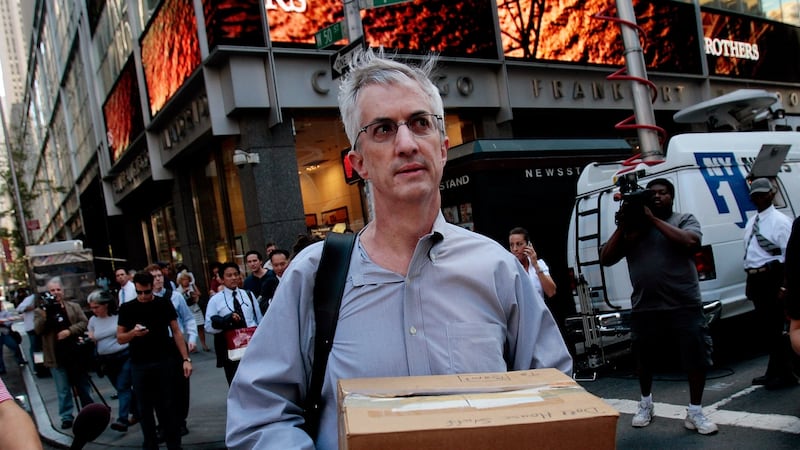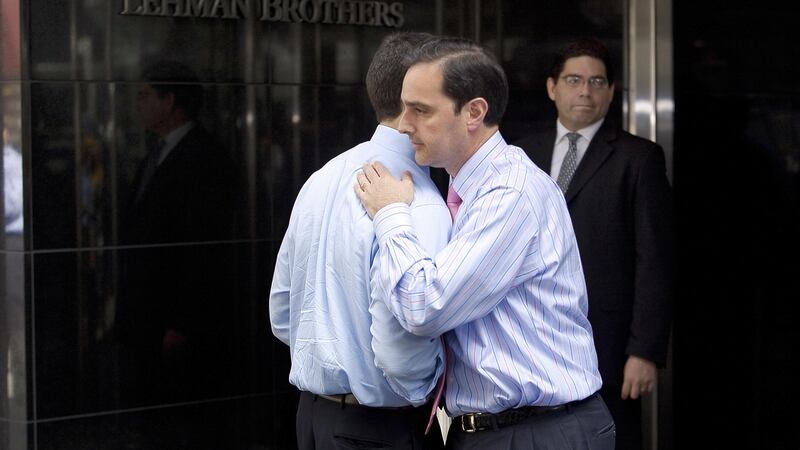On Monday September 15th, 2008, Americans woke to the news that Lehman Brothers, one of the giants of US banking, was filing for bankruptcy. TV screens were filled with images of thousands of shocked Lehman employees streaming out of the bank's headquarters on Seventh Avenue in Manhattan carrying cardboard boxes holding their possessions. By the end of the week, the then president George W Bush had announced an unprecedented $700 billion bailout, Bank of America had bought Merrill Lynch and the Federal Reserve had staged a multi-billion dollar rescue of insurance giant AIG.
Lehman’s collapse was dramatic. But in reality it had been a long time coming.
Wall Street had been basking in an unprecedented period of wealth creation after it emerged from the post-9/11 downturn, helped by cheap credit and an unflinching optimism about the power of the market.
But by 2007 there were signs that something was amiss. By the end of that year America officially entered recession, while in financial markets concerns were brewing about trade in sub-prime mortgages – loans that had been extended to people with low credit ratings.
September and October of 2008 was the worst financial crisis in global history, including the Great Depression
Complex financial instruments had emerged in the years running up to the crash. Credit default swaps – where investors would insure against the possibility of a debt default – became an instrument of choice for investors. Securitisation – the process of repackaging bundles of loans and selling them on under fancy names such as “collateralised debt obligations” – also took off.
The problem was that many of the investors and banks who invested in these instruments didn’t grasp the risk involved. The reality was that part of the makeup of many of these products were underlying loans that were highly risky.
Lehman was at the forefront of the dependence on securitisation, having aggressively moved into mortgage-backed assets in the preceding years. While this high-risk strategy meant record profits, it also left the bank acutely exposed to any fall in asset value.
Throughout early 2008 there were signs that the financial system was coming under threat as the sub-prime mortgage market began to buckle.
Bear Stearns was the first bank to fall. The investment bank collapsed in March 2008 and was sold to JPMorgan Chase. On September 7th, 2008, the US government stepped in and took control of mortgage lenders Fannie Mae and Freddie Mac.
Over the weekend of September 13th and 14th, then treasury secretary Hank Paulson and Federal Reserve chairman Ben Bernanke summoned the chief executives of Wall Street's main investment banks in a bid to save Lehman. They knew that the bank was unlikely to be able to open on Monday. A last-ditch deal to sell the bank to Bank of America and British lender Barclays ultimately fell through. At midnight Lehman Brothers filed for Chapter 11 – the largest bankruptcy filing in American history.
Ten years on, the anniversary of the collapse of Lehman Brothers has sparked some soul-searching across America.

The financial crisis of 2007 and 2008 is still seen as one of the biggest economic crashes in history. As Mr Bernanke famously said: “September and October of 2008 was the worst financial crisis in global history, including the Great Depression.”
The ramifications of the near-collapse of the financial markets were punishing for ordinary Americans. Unemployment soared, peaking at 10 per cent in October 2009, while trillions were wiped off the value of retirement and savings accounts. By 2015, more than 9 million Americans had lost their homes to foreclosure as a result of the 2007-2008 meltdown.
‘Our country is doing great!’
A decade later, how is America faring? According to standard economic indicators the US economy is performing strongly.
GDP growth hit 4.2 per cent in the second quarter of this year, its best performance in nearly four years. Unemployment is at 3.8 per cent, having declined steadily since its 10 per cent peak in 2009. Stock markets have been on an upward trajectory, and are now enjoying what some analysts believe is the longest bull market in history, shirking off corrections earlier in the year.
Unsurprisingly the upbeat economic picture has been seized upon by president Trump. “Our country is doing great!” he tweeted after the publication of the recent GDP figures.
But beneath the feel-good factor, there have been concerns about the longer-term health of the US economy. While consumer sentiment and companies are benefitting from the recent $1.5 trillion Republican tax cut, that boost is likely to be short-term. Similarly, there are fears that escalating trade tensions and tariffs introduced by Mr Trump may hurt the economy. The US debt now stands at more than $21 trillion, while the federal budget deficit is projected to reach $1 trillion by 2020, according to the Congressional Budget Office.
There have also been worrying signs of a slowdown in house-building this summer.
On Wall Street, 10 years on from the financial crash that led to one of the biggest government bailouts in history, earnings are back as equity markets appear to be on an upwards trajectory. In the immediate aftermath of the crisis, a wave of regulations were introduced.
In the US, this centred around the Dodd-Frank Act of 2010. This massive piece of financial regulation signed into law by president Barack Obama included new protection for consumers from corrupt lending practices, tougher liquidity and capital requirements for banks and greater powers for the Federal Reserve to intervene if a bank is failing. The use of many of the riskier financial instruments was curtailed.
But some observers believe the lessons of 2008 may not have been fully learned.
Bankers’ pay in the US has been creeping up to pre-crisis levels, despite widespread acceptance that a culture of excessive pay and bonuses which rewarded reckless risk-taking was partly to blame for the crash.
Moves to roll back elements of the Dodd-Frank Act have also been implemented by the Trump administration. Specifically, Republicans successfully changed a key provision of the Act, increasing the threshold at which banks are subject to enhanced regulation by the Federal Reserve from $50 billion in assets to $250 billion. Similarly, the Consumer Financial Protection Bureau, which is currently headed by Trump's budget chief Mick Mulvaney, has scaled back protections for consumers.
Other remnants of the financial crisis remain in situ. As Arturo Cifuentes of Columbia Business School has recently written, ratings agencies such as Standard and Poor's and Moody's continue to wield huge influence despite having been widely discredited during the financial crisis.
Conflicts of interest and a reluctance to address the real value of assets meant that they continued to give triple-A ratings to tranches of debt that were highly distressed.
‘Not safe enough’
This week, IMF managing director Christine Lagarde warned that the financial system is not entirely safe, despite her belief that the immediate policy response to the crisis was "impressive".
“The system is safer, but not safe enough,” she wrote this week ahead of the Lehman Brothers anniversary, noting that the “too big to fail” concept remains a problem as banks grow in size and complexity.

In addition, she said that banks, particularly in Europe, "probably" need to be better capitalised. "Continued financial innovation – including from high-frequency trading and fintech – adds to financial stability challenges," she added.
But perhaps the biggest impact of the financial crisis in the United States 10 years ago has been political, both in America and Europe. The rise of populism, and a rejection of mainstream party politics, can be seen in part as a reaction to the financial meltdown.
Michael Gove’s famous assertion during the Brexit referendum that “people have had enough of experts” can be partially traced back to the crisis of a decade ago, when supposedly competent authorities such as the US government and regulators who should have known better failed to see the crisis coming, and sought to protect the system rather than taxpayers.
The feeling that bankers were protected while citizens were made to pick up the tab is still discernible.
As economist Paul Krugman put it recently, the chief executives of the largest companies now make 270 times as much as the average worker – up from 27 times as much in 1980.
“GDP numbers have been good in recent quarters, but much of the growth has gone to soaring corporate profits, while median real wages have gone nowhere,” he wrote. Similarly, Christine Lagarde cited a study which suggests the average American will lose $70,000 in lifetime income because of the financial crisis a decade ago.
Not ‘just the economy, stupid’
What all this means for US politics is a critical question as Americans prepare to go to the polls in the mid-term elections in November. On some levels, American society is more willing to welcome strong results on Wall Street, given the high proportion of regular Americans with stock-market investments either through their own portfolios or retirement accounts. What’s good for Wall Street is often good for Main Street.
The strong economy has been touted by president Trump and Republicans as a guaranteed vote-getter, a belief that has appeared to stand the test of time ever since Bill Clinton’s 1992 presidential campaign team coined the phrase: “It’s the economy, stupid.”
But a poll this week suggests that the country’s economic performance may not be as big a driver of voter behaviour in this highly polarised political environment. An ABC-Washington Post poll this week predicts that Democrats will outperform Republicans in the mid-term elections. At the same time, most voters – 58 per cent – believe the economy is “excellent” or “good”, the highest such figure in 17 years.
This suggests the economy does not necessarily translate into votes for the Republican Party. Nearly half of voters who are positive about the economy disapprove of the president's job performance. At least for some voters, dislike for president Trump overrides any support they may have for the current administration's management of the economy. Perhaps it's no longer "just the economy, stupid".

One of the often-forgotten facts about the Lehman Brothers collapse was that it occurred in the final months of a presidential election campaign. In the week running up to the collapse of Lehman in 2008, media coverage was focused on the campaign of Republican nominee John McCain and his running-mate Sarah Palin.
The financial collapse changed the dynamic of the campaign irrevocably. Mr McCain was widely lambasted for claiming that the fundamentals of the economy were sound, then announcing plans to suspend his campaign to deal with the crisis before reversing those plans. Mr Obama, in contrast, who was being privately briefed by senior figures such as Mr Paulson and Mr Bernanke, appeared calm and in control.
Ultimately, this helped deliver him election victory on November 4th, and managing the financial crisis became one of the primary focuses of his presidency.
Whether the economy will be as decisive a factor in voting behaviour in the era of Trump remains to be seen.
As America prepares to mark a decade since Lehman Brothers this week, for some, 2018 looks scarily like the pre-2008 world. It may be too early to assess if this current period of economic expansion can last, but whether it will weigh on voters’ minds when they go to the polls in two months’ time is another matter.











